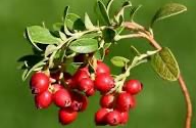Cranboggy Culture
by Julie Barnes

Thanksgiving is a day for us to come together with family and friends to share a festive meal. A traditional dinner includes some combination of turkey, mashed potatoes, gravy, stuffing, pumpkin pie, and, for more than 94% of us, cranberry sauce. Native American people called the cranberry ibimi which means bitter fruit. To the settlers, its flowers resembled the head and bill of a crane so they called this fruit "crane berry" which eventually became shortened to cranberry. Native Americans used cranberries as a meat preservative and also, as ingredients in medicines. To prevent scurvy, American sailors carried Vitamin C rich cranberries on their vessels. Besides the Concord grape and blueberry, the cranberry is one of the few fruits native to North America and is grown primarily in Massachusetts, Wisconsin, New Jersey, Oregon, and Washington. This member of the Eriaceae (heath or heather) family thrives in acid soil along with its relatives the rhododendron, azalea, and blueberry. In conditions intolerable to other crops, this unique fruit flourishes in the cool temperatures and nutrient impoverished acid soil common to wetlands. Since this environment is hard to create, the cranberry cannot be grown as a home fruit.
Cranberries grow on vines just like strawberries in sandy bogs or marshes. Low areas of natural bogs were originally formed by glacial deposits. For trapping and retaining rain water, a clay lined bottom is covered with sponge like layers of peat. The addition of sand, peat, and gravel then transforms a bog into a cranberry farm. By attaching flood gates, the amount of water from marshes above this area is then controlled to sustain the cranberry crop. So, contrary to what many people believe cranberries do not grow in water.
The growing season for cranberries lasts from April to November. Because cranberries are sensitive to frost, sprinklers provide warmth to the plants by misting them with water in the event of a freeze. Once star like blossoms cover the plants, growers have beekeepers transport in hives to pollinate the crop. When the cranberries become fully mature most bogs are flooded with water. Fruit dislodged by machines floats to the surface for wet harvesting and is designated for production of juices, jellies or sauces. On the other hand, cranberries that are to be sold fresh are treated differently because they must be firm. These fruits are mainly dry harvested by machines or rakes that gently "comb" the cranberries from the plants into sacks. Good, ripe cranberries will bounce from small pockets of air inside them. A bounce test is given to fresh berries in a sorting mill. Those that pass will be bagged while fruit failing to bounce is used for juices or other foods. Dried cranberries or "Craisins" have become popular for snacking and baking and are prepared by adding a sugar solution to the fresh fruit as it dehydrates.
When the season is over, all the bogs are filled with water to provide a protective layer of ice for the tender buds of next year's crop. The cranberry growers will then spread an inch of sand over top of the ice on each cranberry bed. As the ice melts in the spring, the sand will sink to the bottom to smother weeds, bury insect eggs, and provide extra support to established plants beginning a new season.